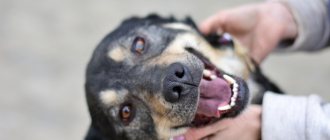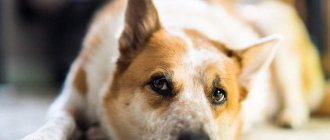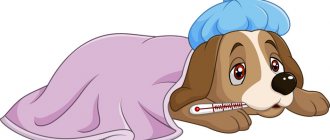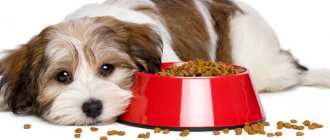Adult dogs have a bowel movement once or twice a day while walking. Have you noticed that your pet can't go to the toilet? This is constipation.
You will learn why constipation occurs, how to help a dog with constipation on your own, and in what cases to seek veterinary help.
I’ll tell you the dangers of inaction, how and with what laxatives to treat your pet.
I will describe step by step the algorithm of your actions when administering an enema and giving a laxative.
What is considered constipation? Constipation is the absence of bowel movements for two days or incomplete and painful passage of feces. Dogs of all ages are susceptible to the disease.
Descriptions and prices are current as of November 2022 and are constantly updated.
When to talk about constipation
You should think about treating constipation in dogs only when bowel movements have not been observed for several days. Depending on the severity of the condition, bowel movements may be completely or partially absent.
Adult dogs defecate 1-2 times a day, older dogs - once every two days, and puppies - up to 5 times a day. This is explained by the metabolic rate, which reaches its maximum at an early age.
In addition to frequency, it is important to consider the appearance of the feces. The feces of a healthy animal have an oblong shape, soft consistency and dark brown color. Failure to comply with at least one of the points is a serious cause for concern.
Treatment
If home therapy does not bring relief to the animal within 24 hours, you need to go to the clinic.
Conservative treatment of constipation should be comprehensive. It includes:
- following a special diet;
- taking medications;
- exercise stress.
If difficulties with defecation occur against the background of chronic pathology, emphasis will have to be placed on treating the underlying disease. In some cases, only emergency surgery can save your pet.
When do you need veterinary help?
You should not hesitate to seek professional help when your dog has completely lost stool for more than two days, and the following symptoms are additionally observed:
- painful defecation;
- feces smell rotten;
- refusal to eat;
- blood and fragments of undigested foods are noticeable in the feces;
- depressed state;
- nausea;
- elevated temperature;
- anxiety when palpating the abdomen;
- bloating;
- repeated vomiting.
If you have one or more of these signs, you should immediately visit a veterinarian. The clock can count!
Doctor's actions
At the appointment, the specialist will examine, palpate the animal, and interview the owner. The doctor needs to describe in as much detail as possible:
- age, lifestyle of the pet;
- how a dog goes to the toilet;
- what does it eat;
- is there vomiting?
- appearance of all discharge;
- changes in behavior.
To clarify the preliminary diagnosis, the veterinarian prescribes;
- X-ray examination;
- blood analysis;
- Ultrasound of the abdominal cavity.
Based on the data received, the doctor will determine the cause of the disorder and prescribe adequate treatment. If necessary, perform intestinal lavage or surgical intervention.
Symptoms of constipation in dogs
Problems with stool quickly affect the emotional state of the pet. He becomes restless, loses his usual cheerfulness and refuses to play. Soon other symptoms and signs of constipation in the dog appear, confirming the concerns:
- bloating, hardening and rumbling of the abdomen;
- loss of appetite;
- pain when palpating the abdominal cavity;
- frequent but unsuccessful attempts to defecate, accompanied by whining;
- the appearance of vomiting and fever;
- reducing the volume of feces, drying them out and compacting them.
If the intestinal walls are severely damaged, the stool will contain blood particles. In this case, it is better to entrust treatment to a veterinarian.
Possible causes of the problem
You can find out how to treat constipation in a dog only after identifying the cause. Delayed defecation is only a consequence, not an independent disease. In addition to improper nutrition and care, disturbances in the outflow of feces are provoked by parasitosis, physiological and even psychological factors.
The risk group includes pregnant pets. In addition to changes in hormonal levels, the cause is an enlarged uterus, compressing the intestinal loops.
Elderly age
In addition to a slowdown in metabolism, aging is accompanied by a decrease in muscle tone and deterioration in peristalsis. The problem that has arisen is aggravated by compassionate owners who reduce the “old man’s” usual activity and pamper him with previously forbidden delicacies.
Infection with worms
The accumulation of helminths narrows the lumen in the intestines, disrupting its patency. Parasites also cause damage to the mucous membranes, causing irritation.
Foreign bodies in the intestines
Puppies are guilty of swallowing foreign objects because they want to try everything they see. Stuck pieces of wood, toys or stones block the exit of feces.
Poor nutrition
Delayed bowel movements occur when feeding a puppy with goat's or cow's milk. Instead, it is recommended to feed a motherless baby with ready-made milk formulas for dogs.
When feeding high-quality dry food, the intestines work uninterruptedly. The opposite situation is observed in animals that eat natural products. Intestinal disorders are explained by a lack of fiber, consumption of prohibited foods (these include sweets, processed foods, flour, spicy foods) or a high-protein diet.
Binge eating
Excessive amounts of food are not used for daily energy production and are stored as fat. The body does not have time to cope with such volumes, so food particles settle on the intestinal walls. Over time, they dry out and harden, interfering with emptying.
Physical inactivity and excess weight
Physical inactivity is a small amount of activity. It occurs in animals that rarely go outside and in overweight pets. Excess fat deposits are detrimental to internal organs. The removal of feces is complicated due to compression of the intestine.
Short or too leisurely walks slow down peristalsis. The number of intestinal contractions decreases, which leads to congestion and blockage of the gastrointestinal tract.
Gastrointestinal injuries from eating bones
Constipation in a dog after eating bones occurs due to gastrointestinal trauma. Small and sharp bones of river fish are especially dangerous. If severely wounded, they can cause death from blood loss.
Long and thick coat
Pets with long and thick hair require more careful care. Infrequent brushing of fur provokes frequent licking and leads to the accumulation of fur in the intestines. Hairballs, called trichobezoars, block the path of feces. Defecation is also complicated when tangles appear near the anus, blocking the passage from the outside.
Consequences of treatment
Often, stagnant processes are explained by a recent operation or prolonged use of medications. In the first case, the decrease in the tone of the intestinal walls is associated with anesthesia, and in the second - with antibiotics, iron-containing and astringent drugs that have a detrimental effect on the microflora.
Dehydration
Lack of fluid prevents the smooth passage of stool. Hardened feces begin to injure the mucous membranes, causing a reflexive contraction of the anus.
This problem is especially relevant for animals that eat dry food. Processing pellets requires a lot of water. If the amount of fluid entering the body is too small, then reserves are replenished directly from the feces.
Prevention of the disease
To avoid the development of causes and the appearance of constipation itself, it is important to follow several preventive rules:
- Improving the diet, observing feeding standards;
- Using high-quality dry food, providing the dog with all the vitamins and the right amount of water;
- A natural menu should be varied, containing proteins, fats and carbohydrates; It is recommended to feed dogs vegetables, fruits, and dairy products;
- The presence of beef tripe in the diet promotes the breakdown and digestion of food;
- Timely deworming (cleansing of worms);
- Maintaining good physical shape, active walks, training;
- The owner must watch what his pet is trying to pick up and eat.
What can you do if your dog is mildly constipated?
Self-medication is permissible only if the delay in defecation is no more than 3 days. The pet's condition must be satisfactory. Otherwise, it is safer to go to a veterinary clinic.
Vaseline oil
If it is not possible to ask your doctor what to do if your dog is constipated, you can use Vaseline oil at home. This is the safest stool thinner. It is not absorbed by the body, which means you won’t be able to overdo the dosage.
To alleviate your pet's condition, pour Vaseline oil into the mouth, close his jaws and hold them for a while. Gradually, the medicine will reach the intestines through the esophagus, lubricate its walls and exit through the anus.
The dosage is calculated by weight: 1 ml of oil is used per 1 kg of animal weight.
The medicine is given twice a day until the usual bowel movements return. The first improvement occurs within 5 hours after injection. Vaseline oil is contraindicated during pregnancy, inflammation of the peritoneum and intestinal obstruction.
Enema
Vaseline oil is infused not only orally, but also through an enema. In this case, the effect appears within 5-15 minutes. The basis of the enema is water. In addition to Vaseline, glycerin, chamomile decoction, soap solution or fish oil are added to the enema. The volume of liquid is calculated depending on the size of the animal:
- 1 liter with a weight over 40 kg;
- 0.5 l with a weight of 20-40 kg;
- 0.2 l with a weight of less than 20 kg.
If the pet is less than 1 year old, then the amount of liquid is reduced to 1 tablespoon, and all additional impurities are excluded. Despite its effectiveness, the procedure is contraindicated if:
- severe dehydration;
- injuries or neoplasms in the gastrointestinal tract;
- pregnancy;
- high temperature;
- frequent vomiting;
- increased breathing and pulse;
- the slightest suspicion of intestinal obstruction;
- kidney or heart diseases;
- bleeding from the anus.
Due to so many restrictions, it is best to entrust the enema to a veterinarian. When introducing liquid yourself, watch its entrance into the anus. If it flows out and does not pass through the anus, stop the procedure and urgently take the animal to a veterinary clinic. This condition is typical for intestinal obstruction, which can lead to intestinal rupture.
Folk remedies and methods
Among folk remedies, it is recommended to use kefir, oat or flax infusions and products with a laxative effect (beets, prunes, plums, fresh carrots). To get the desired effect, consider the size of the animal. A small breed dog needs a couple of teaspoons of kefir, but a large dog will need a whole glass.
To prepare the infusion, pour 1 tbsp. l. oat or flax grains 100 ml boiling water. Infuse the resulting mixture for an hour and dispense twice a day before meals.
Typical situations
According to statistics, the most common diseases that are caused by this disorder are:
— problems with the prostate (typical, of course, for male dogs);
- malfunction of a pair of anal glands;
- lesions, deviations from the normal activity of various organs: kidneys, glands, etc.;
- inflammatory processes that occur mainly in the groin area, in the intestines and the anus;
— neurology;
- malfunction of the musculoskeletal system.
How to fix the problem
The dog's owner can identify the first symptoms. And after that, you don’t have to wait a whole month without making any decisions. The sooner the diagnosis is made and treatment is prescribed, the sooner the animal will recover without any serious consequences for the body.
Only an experienced veterinarian is able to recognize an objective cause for obvious symptoms. If necessary, an additional examination is prescribed, based on the results of which a clear, consistent treatment plan and subsequent preventive and restorative procedures can be drawn up.
An important addition: if there is no bowel movement for three days, there can be no talk of any solution to the problem at home, be it an enema or a laxative. It is necessary to urgently consult a doctor, and delay is unacceptable, since after 5 days processes begin that lead to death.
When to see a doctor
If there is a prolonged absence of defecation and the effect of home treatment, if alarming symptoms appear, the pet should be taken to the veterinarian. After diagnosis, the doctor will tell you what to give your dog for constipation and determine whether surgery is necessary.
Alarming symptoms
If there is no stool for more than 2-3 days, the animal must be examined at a veterinary clinic. The accumulation of feces leads to severe intoxication, so delay can be disastrous.
Poisoning is accompanied by constant weakness, fever, repeated vomiting and severe dehydration. Lack of water is noticeable by sunken eyeballs, dry gums and nose. No less alarming is the appearance of blood or undigested food particles in the feces, as well as their putrid odor.
Procedures at the veterinary clinic
To determine the possible cause that affected the four-legged patient’s condition, the clinic takes his blood test, performs an ultrasound and x-ray. These studies help identify concomitant diseases, detect parasites or foreign objects.
Depending on the diagnosis, treatment can be medicinal or surgical. Taking laxatives and administering enemas is limited to small fecal accumulations. If a foreign body or intestinal obstruction is detected, the patient is scheduled for surgery. After all procedures have been completed and the pet’s condition has been stabilized, the pet is sent home and prescribed a therapeutic diet.
What laxatives will the vet prescribe?
All laxatives affect the body differently, so never prescribe them yourself. Medicines from the human medicine cabinet are especially dangerous for animals - they actively stimulate smooth muscles, which can cause rupture of the intestinal walls. These laxatives include Bisacodyl and Guttalax. It is safer to use drugs developed specifically for animals: Vetelact and Laxatone.
Laxatives for dogs with constipation help:
- Urgently have a bowel movement
. These include emollients (Docusate sodium) and stimulants (Bisacodyl). They are contraindicated during pregnancy and lactation.
- Increase fecal volumes or moisten intestinal walls
. Bulk-forming drugs (Metamucil) draw moisture from neighboring cells, facilitating passage through the intestine. Also, free sliding is achieved with the help of lubricating laxatives (hair removal paste).
- Soften stool
. For this purpose, osmotic preparations (Lactusan, Duphalac) are used, which have a beneficial effect on the microflora. Their only drawback is their slow action. In an emergency, it's better to use something else.
All medications are selected by a doctor, since self-medication can result in severe dehydration. A number of human laxatives are suitable for animals, but it is best to check with your doctor for safe dosage and possible contraindications.
How much solution is needed to wash the intestines?
When determining the amount of liquid for an enema, it is necessary to take into account the dog's live weight.
- For a dog weighing up to 20 kg, the amount of liquid injected into the rectum is about 200 ml.
- If the dog weighs from 20 to 40 kg, administer about 500 ml.
- If the dog weighs 50 kg, about 1 liter of liquid must be injected into the rectum.
To administer an enema to large dogs, use an Esmarch mug, which is hung or held by an assistant at a height of 1 meter. For dogs with low live weight, as well as dogs of small breeds, use syringes or rubber bulbs.
In order to relax the intestines, relieve pain and relieve spasms when administering liquid, before the enema procedure, it is a good idea to inject the dog intramuscularly with Baralgin or No-ShPU (0.1 ml per 1 kg of live weight).
What to feed a sick animal
During treatment, it is recommended to exclude solid and dry foods, animal proteins and fatty meat broths. When dry feeding, granules are temporarily replaced with wet spiders or canned food. When feeding naturally, the diet includes fermented milk products and boiled vegetables (pumpkin, carrots, zucchini), as well as water porridge and well-cooked sea fish.
To retain fluid in the body, in addition to ordinary water, Regidron solution is used. It helps avoid dehydration and soften stool.
All about puppy constipation
Delayed bowel movements in newborn puppies are often due to lack of abdominal massage. Usually it is performed by the mother, who licks the bellies of her children, but with a large litter, she does not always cope with her task. A similar problem arises with artificial feeding. In this case, the breeder should stimulate the peristalsis of his four-legged charges.
Another possible cause is trichobezoars or foreign objects. They are removed using laxatives or surgery under the supervision of a veterinarian.
The puppies' bodies are very weak, so don't let them go without stool for more than a day. It is also not recommended to do an enema yourself: the thin walls of the intestines are easily damaged, so it is better to immediately examine pets under one year of age in a veterinary clinic.
Foreign objects
Due to their curiosity, puppies quite often swallow inedible objects. If the foreign object has a streamlined shape and does not have sharp corners, it will exit the digestive system naturally. Unfortunately, puppies quite often swallow dangerous objects: needles and threads, Christmas tree tinsel, plastic bags, small parts from children's construction sets, fragments of rubber toys, slivers from sticks.
Any foreign object that gets stuck in the intestinal lumen can cause a blockage. Splinters from the sticks can become embedded in the intestinal wall, causing swelling, inflammation, and physical closure of the lumen. Intestinal blockage is treated with medication or surgery. To confirm the diagnosis and prescribe further therapy, an x-ray with a contrast agent will be required.
Constipation, as a phenomenon, can be a symptom of intestinal volvulus. Unlike blockage, volvulus is a deadly condition that quickly leads to intoxication and sepsis. Regardless of age, with intestinal volvulus, a dog dies within a day at most. The pathology can only be eliminated surgically.
Note! The most common cause of intestinal volvulus is walking or active play immediately after eating.
Megacolon is a congenital disorder that is accompanied by dilation of the large intestine. The disorder occurs during intrauterine development. Puppies suffering from megacolon suffer from constipation from a very early age. Unfortunately, the pathology cannot be treated with medication, but sometimes the situation can be corrected promptly.











